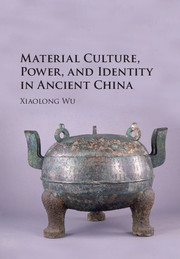Book contents
- Frontmatter
- Dedication
- Contents
- List of Figures
- List of Maps
- List of Tables
- Acknowledgments
- INTRODUCTION
- 1 HISTORICAL SETTING AND APPROACHES TO THE STUDY OF AN ANCIENT STATE IN WARRING STATES CHINA
- 2 LIFE, DEATH, AND IDENTITY IN ZHONGSHAN: SORTING OUT THE ARCHAEOLOGICAL EVIDENCE
- 3 ROYAL MORTUARY PRACTICE AND ARTIFACTS: HYBRIDITY, IDENTITY, AND POWER
- 4 INTERSTATE POLITICS AND ARTISTIC INNOVATION DURING THE REIGN OF KING CUO
- 5 STATECRAFT AND ZHONGSHAN BRONZE INSCRIPTIONS
- 6 FUNERARY ARCHITECTURE, KINGLY POWER, AND COURT POLITICS
- CONCLUSION
- Appendices
- Notes
- Bibliography
- Index
6 - FUNERARY ARCHITECTURE, KINGLY POWER, AND COURT POLITICS
Published online by Cambridge University Press: 23 March 2017
- Frontmatter
- Dedication
- Contents
- List of Figures
- List of Maps
- List of Tables
- Acknowledgments
- INTRODUCTION
- 1 HISTORICAL SETTING AND APPROACHES TO THE STUDY OF AN ANCIENT STATE IN WARRING STATES CHINA
- 2 LIFE, DEATH, AND IDENTITY IN ZHONGSHAN: SORTING OUT THE ARCHAEOLOGICAL EVIDENCE
- 3 ROYAL MORTUARY PRACTICE AND ARTIFACTS: HYBRIDITY, IDENTITY, AND POWER
- 4 INTERSTATE POLITICS AND ARTISTIC INNOVATION DURING THE REIGN OF KING CUO
- 5 STATECRAFT AND ZHONGSHAN BRONZE INSCRIPTIONS
- 6 FUNERARY ARCHITECTURE, KINGLY POWER, AND COURT POLITICS
- CONCLUSION
- Appendices
- Notes
- Bibliography
- Index
Summary
DURING THE WARRING STATES PERIOD, THE ZHOU COURT HAD long been eclipsed by former regional states that had become independent kingdoms. Ruled by a new elite who had just assumed power, these kingdoms competed constantly with each other for territory. In order to survive in the Warring States environment, rulers sought ways to strengthen their own states, and initiated political and economic reforms that greatly altered the social structure. Traditional art and architectural forms also experienced dramatic changes in response to the needs of the new political elite. As a major symbol of political power, traditional Zhou ancestral temples with great horizontal expansion were replaced by grand palaces and mausoleums with soaring height, characterized by imposing halls, verandas, and galleries built on tall platforms. Huge terrace foundations of rammed earth have been found in the capital cities and at the royal tombs of the powerful states of this period.
The earliest preserved architectural plan in China, cast on a bronze panel, was excavated in the main burial chamber of King Cuo's tomb (see Figure 5.3). As its inscription tells us, the inlaid gold and silver lines indicate the ground plan of his mausoleum, including the tombs of his queens and other consorts. Like many other bronze artifacts commissioned by King Cuo, this bronze plaque was inspired by his political agenda. A study of this bronze artifact in the context of this mausoleum opens new ways to understand the role of visual images in the memorialization of power in early China. Objects such as this bronze plaque enact King Cuo's political intentions, facilitate the maintenance of political order within the kingdom, and illustrate the role that gender played in the creation of a public image that memorialized the Zhongshan king.
The inscriptions on this plaque give the names of architectural structures, their size, and the distance between them (Figure 6.1). This plan indicates that Cuo's mausoleum is composed of a rectangular compound enclosed by two walls; the outer wall is about 410 meters long and 176 meters wide, and the inner wall 340 meters by 105 meters. Inside these walls, five grand halls with square foundations stand on top of a terraced structure. At the center of the precinct is the Hall of the King, flanked by the halls of his two successive queens.
- Type
- Chapter
- Information
- Material Culture, Power, and Identity in Ancient China , pp. 171 - 179Publisher: Cambridge University PressPrint publication year: 2017



